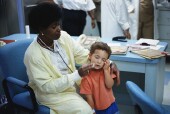
MONDAY, Oct. 5, 2015 (HealthDay News) — The early signs of child abuse among infants and toddlers — head trauma, cracked ribs or abdominal injuries — are often missed, and that may be due in part to a lack of standardized screening, researchers report.
“We probably need to increase testing for abusive injuries, but these data are less about an increase or decrease and more about consistency,” said study author Dr. Daniel Lindberg, from the Kempe Center for the Prevention and Treatment of Child Abuse and Neglect in Denver.
“If your child has a femur fracture, the decision to test for other abusive injuries shouldn’t depend on the hospital you go to, or the color of your skin, or your net worth or your demeanor,” Lindberg said.
“This study suggests that young kids who present with the most concerning sentinel injuries should at least prompt the provider to consider whether abuse is likely and, as recommended by the American Academy of Pediatrics, should prompt them to perform a careful physical examination and obtain other tests to look for hidden abusive injuries,” he added.
Such tests would include a physical exam, X-rays, blood tests and CT scans for internal injuries. A skeletal survey, which is a set of X-rays to look for hidden fractures, is particularly important, Lindberg explained.
“The key thing this study tries to recommend is that we move toward a more routine, consistent approach to abuse testing, and away from an approach that is based on a doctor’s impression of how parents are acting or whether there are other known risk factors,” Lindberg said.
The findings were published online Oct. 5 in the journal Pediatrics.
One expert agreed that more consistent screening would spot more cases of child abuse.
“Pediatricians and other medical providers who care for abused and neglected children have long recognized that specific injuries are more often associated with abuse,” said Dr. Thomas Valvano, medical director of the Suspected Child Abuse and Neglect (SCAN) Program at Oregon Health and Science University’s Doernbecher Children’s Hospital.
“The use of protocols [based on evidence] for evaluating children with injuries associated with an increased risk of abuse can also reduce the likelihood that abuse will be misdiagnosed,” Valvano said.
An estimated 600 children die from child abuse each year, while another 119,000 continue to suffer from it annually, the study noted. Yet, one in five abuse-caused fractures and up to 30 percent of abusive head traumas are missed by doctors the first time, leaving children vulnerable to further abuse.
The researchers examined the records of more than 4.1 million children under the age of 2 who had been seen at one of 18 different medical institutions during a seven-year period.
From these records, the researchers identified just over 30,000 children who had sentinel injuries, such as bruises or burns in young infants, brain bleeding or fractures in children under 1, and rib fracture, abdominal injuries, genital injuries or bleeding behind the retinas for children under the age of 2.
The researchers excluded children who had been in a car accident or had been previously diagnosed with child abuse. Most of these children — 90 percent — had only one potentially suspicious injury.
Among all the children under 2 years of age, 0.17 percent had been victims of child abuse, but percentages were higher among those with sentinel injuries. For example, 3.5 percent of children under 1 year old with burns and 56 percent of children under 2 years old with rib fractures had been abused. Among those with rib fracture, severe abdominal injury or bleeding in the skull, at least one in five children had been abused, according to the study.
Yet medical test usage for identifying abuse varied greatly across hospitals, the investigators found. For example, anywhere from 20 percent to 74 percent of the children received skeletal surveys, depending on the center.
“While the results from the study are not surprising, they do serve as a constant reminder for medical providers on the front lines to be vigilant for red flags in the types of patients’ injuries and injury pattern, as well as the behavior and detail disclosed in the history surrounding the injury or injuries,” said Dr. Robert Glatter, an emergency physician at Lenox Hill Hospital in New York City.
“Doing a thorough history and physical exam, and always maintaining a high index of suspicion for child abuse when the injuries don’t match with a history obtained from parents or caregivers is essential to avoid missing cases of child abuse,” Glatter said.
The study reveals the importance of establishing a more standardized protocol for assessing possible child abuse, Lindberg said.
Valvano added that while more child abuse cases may be identified with routine screening, that does not necessarily mean more children will be misdiagnosed as abused when they were not.
“The evaluation of child abuse is a multidisciplinary process involving medical providers, child protective services and law enforcement,” Valvano said. “Referring children for evaluation by medical providers with expertise in the field of child abuse is key. Child abuse specialists are trained to differentiate between accidental and abusive injuries, and often diagnose accidental injury.”
Further, proper testing should rarely lead to “false positives,” Lindberg suggested.
“For the most concerning injuries in this study, the risk of abuse is high enough, the risk of missing that abuse is high enough and the risks of testing small enough, that testing should be routine,” Lindberg said.
Others who notice suspicious injuries — especially any bruising in infants under 6 months old — can play a role in preventing child abuse, too, he added.
“Family and friends should feel empowered to ask about these injuries, and if there isn’t a great explanation, they should know that anyone — not just doctors — can report a reasonable concern for abuse,” Lindberg said.
More information
For more on preventing child abuse, visit the U.S. Centers for Disease Control and Prevention.
Copyright © 2025 HealthDay. All rights reserved.

